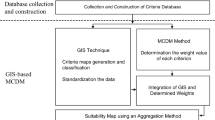Abstract
Designing environmentally safe and economically feasible landfills can be a challenging task due to complex interactions that need to be taken into account between landfill size, waste and site characteristics. The main focus of this study is, by interfacing the geographic information systems (GIS) with system simulation models (SSM), to develop a methodology and a landfill design component selection matrix that can enable the determination of landfill design components providing the desired performance with minimal design details. In this paper, the conceptual framework and applications of the developed methodology demonstrating the selection of landfill design components that are suitable for the existing site conditions are presented. The conceptual model defines design variables, performance criteria and design components of a landfill. GIS and SSM are used to handle the site-specific data and to evaluate the landfill performance, respectively. Results indicate that the landfills having the same design characteristics show different performance under different site conditions; therefore, a landfill design that is technically and economically feasible should be selected on the basis of performance.


Similar content being viewed by others
Abbreviations
- GIS:
-
Geographic information systems
- SSM:
-
System simulation models
- MSWLF:
-
Municipal solid waste landfill
- MRD:
-
Maximum rate of waste deposition
- CDS:
-
Cover drainage system
- LCS:
-
Leachate collection system
- K :
-
Hydraulic conductivity
- P :
-
Annual precipitation
- C max :
-
Maximum chloride concentration
- MCL:
-
Maximum concentration level
- q o :
-
Rate of leachate production from waste
- q c :
-
Leachate collection (or drainage) rate
- q l :
-
Leachate leakage rate from the landfill bottom
- A :
-
Landfill area
References
Aller LA, Benett T, Lehr JH, Hackett G (1987) DRASTIC: a standardized system for evaluating ground water pollution potential using hydrogeological settings, EPA/600-2-85/018, Washington DC
Dörhöfer G, Siebert H (1998) The search for landfill sites—requirements and implementation in Lower Saxony, Germany. Environ Geol 35(1):55–65
ESRI (2000) ArcGIS manual, USA
European Union (1999) The council directive on the landfill of waste (99/31/EC), OJ 182, 16.7.99
Federal Register (1991) Solid waste disposal facility criteria; final rule, 40 CFR Parts 257 and 258, vol 56, No. 196, USA
Hauser VL, Weand BL, Gill MD (2001) Natural covers for landfills and buried waste. J Environ Eng 127(9):768–775
Kampf SK, Salazar M, Tyler SW (2002) Primary investigations of effluent drainage from mining heap leach facilities. Vadose Zone J 1:186–196
Koerner RM, Soong TY (2000) Leachate in landfills: the stability issues. Geotext Geomembr 18:193–309
Lukasheh FA, Warith MA (2001) Review of expert system (ES), geographic information system (GIS), decision support system (DSS), and their applications in landfill design and management. Waste Manage Res 19:177–185
Rowe KR, Quigley RM, Booker JR (1995) Clayey barrier system for waste disposal facilities. E&FN Span, UK
R.S.A Department of Water Affairs and Forestry (1998) Minimum requirements for waste disposal by landfill, 2nd edn. CTP Book Printers, Cape
Ünlü K, Kemblowski MW, Parker JC, Stevens D, Chong PK, Kamil I (1992) A screening model for effects of land-disposed wastes on groundwater quality. J Contamin Hydrol 11:27–49
Waterloo Hydrogeologic (2002) Visual HELP User’s Manual – Predicting Landfill Hydrology and Optimizing Landfill Designs, Canada
Acknowledgements
The authors would like to thank Turkish Scientific and Technical Research Council for supporting the project (Project Code: İÇTAG Ç-047), and for supporting the Ph.D. studies of Ms. Başak Tarhan.
Author information
Authors and Affiliations
Corresponding author
Rights and permissions
About this article
Cite this article
Tarhan, B., Ünlü, K. Performance-based landfill design: development of a design component selection matrix using GIS and system simulation models. Environ Geol 49, 133–147 (2005). https://doi.org/10.1007/s00254-005-0073-4
Received:
Accepted:
Published:
Issue Date:
DOI: https://doi.org/10.1007/s00254-005-0073-4







